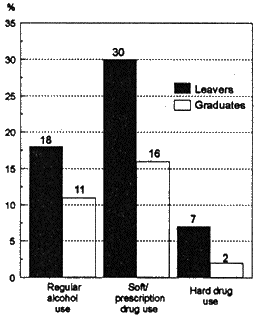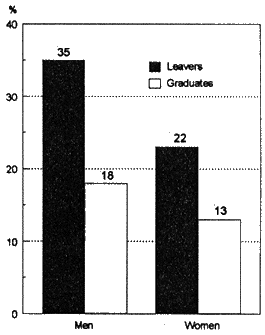Leaving School - Results From a National Survey Comparing School Leavers and High School Graduates 18 to 20 Years of Age - January 1995
| Previous | Contents | Next |
7. Patterns of Student Deviance
Introduction
Leavers are more likely than graduates to engage in a number of activities that involve a degree of rebellion or insubordination, and therefore, might be considered deviant. These activities include regular alcohol consumption, soft and hard drug use (Chart 7-1).
Chart 7-1
Alcohol and Drug Use in Last Year of School, Leavers and Graduates

Statistics Canada School Leavers Survey
Leavers, whether male or female, generally reported that they had engaged in these practices more frequently and regularly than did their graduate counterparts.
Not surprisingly, since some of this behavior is beyond the limits of the law and many lead to other illegal activities, leavers also had a higher rate of conviction than did the graduates45. If these deviant behaviours tend to be associated more with leavers than with graduates, are they potential early warning signs of students with an above average risk of dropping out?
Alcohol Consumption
A majority of students, both leavers and graduates, consumed alcohol to some degree during their last year of school. In fact, a higher proportion of graduates (75%) than leavers (67%) reported that they had done so. Female graduates were much more likely to report some degree of alcohol use than were female leavers (73% versus 56%) while similar proportions of male leavers (74%) and graduates (77%) consumed alcohol in their final year (Chart 7-2).
Leavers, however, were more likely than graduates to be regular rather than occasional drinkers46. Whereas 18% of leavers reported that they had consumed alcohol regularly, the corresponding proportion among graduates was 11% (Chart 7-1).
Male leavers tend to have the greatest likelihood of being regular drinkers, with 21% reporting consumption during their final year of school.
Chart 7-2
Alcohol Use in Last Year of School, Leavers and Graduates by Gender

Statistics Canada School Leavers Survey
Regular drinking was less common among women (Chart 7-3)
Chart 7-3 Regular Alcohol Consumption in Last Year of School, Leavers and Graduates by Gender

Statistics Canada School Leavers Survey
Soft Drugs
The use of soft drugs such as marijuana and hashish, and the misuse of prescription drugs such as tranquillizers, was much less common than alcohol consumption among students. Leavers, however, were considerably more likely than graduates to report that they had engaged in these activities.
In fact, the proportion of leavers who had used soft drugs or misused prescription drugs (30%) was nearly double the proportion of graduates ( 16%) (Chart 7-1). For both groups, these activities tended to be experimental rather than regular, with 22% of leavers and 14% of graduates reporting experimental use. Few members of either group were regular users, but again, this level of consumption was reported more often by leavers than graduates: 9% compared with 1%*. 47
Men tended to use soft drugs or to misuse prescription drugs more frequently than did women. Yet regardless of their gender, a higher proportion of leavers than graduates had engaged in these activities (Chart 7-4).
Chart 7-4
Soft/Prescription Drug Use in Last Year of School, Leavers and Graduates by Gender

Statistics Canada School Leavers Survey
Hard Drugs
Hard drug use was relatively rare among students during their last year of school. Even though few individuals reported using substances such as cocaine, heroin, speed and LSD, leavers were over three times as likely as graduates to admit that they had done so: 7% versus 2% (Chart 7-1).
Hard drug use was higher among leavers of both genders than among their graduate counterparts. While 8%* of male leavers had used these substances, the rate among male graduates was just 3%. The disparity was similar among women; however, the proportions were too small to be reliable.
As was the case for soft drugs, hard drug use among both groups tended to be experimental rather than regular. About 5%* of leavers and 2% of graduates were experimental users of hard drugs.
Other Substances
Misuse of other substances such as glue or solvents was even less prevalent among students than was hard drug use. In fact, 98% of leavers and 99% of graduates had never engaged in such activities in their final year.
Substance Abuse
Overall, just 18% of students had engaged in substance abuse of any sort, (except alcohol consumption) during their last year of school. However, the proportion of leavers who reported at least one of these activities (32%) was double the proportion of graduates (16%). As well, regular substance abuse was far more common among leavers than graduates, with 9% of the former, compared with 1 %* of the latter, indicating that they had used these substances "often."
Criminal Offenses
A small percentage of students had been convicted of a criminal offense (excluding parking and speeding tickets) during their last year of school. However, the overall rate of conviction among leavers (12%) was four times that among graduates (3%) (Chart 7-5).
At 16%, the criminal conviction rate was highest for male leavers and far exceeded that of male graduates (4%). Women were much less likely to have been convicted of a crime, and in fact, the proportions were too small to be reliable.
Chart 7-5
Criminal Convictions During Last Year of School, Leavers and Graduates

Statistics Canada School Leavers Survey
Summary
During their last year of school, leavers engaged in substance abuse more frequently and regularly than did graduates. As well, a much higher proportion of leavers than graduates had criminal records.
Although participation in such activities may not necessarily lead to the decision to leave school, these deviant behaviour patterns may act as red flags, indicating students at greater risk of leaving school before graduation.
45 Students were asked about their alcohol consumption, drug use, and criminal records during their last year of school. The time in question varies for different individuals, as they did not all leave school in the same grade or at the same age. Thus, alcohol consumption, for example, would have been illegal for those who left school before they reached the drinking age, but not for older students.
46 Students who reported that they consumed alcohol "rarely" or "sometimes" were classified as "occasional" drinkers; those who drank "often" were classified as "regular" drinkers.
47 Students who indicated that they used drugs "rarely" or "sometimes" were classified as "experimental" users; those who reported that they used drugs "often" were designated "regular" users.
| Previous | Contents | Next |



